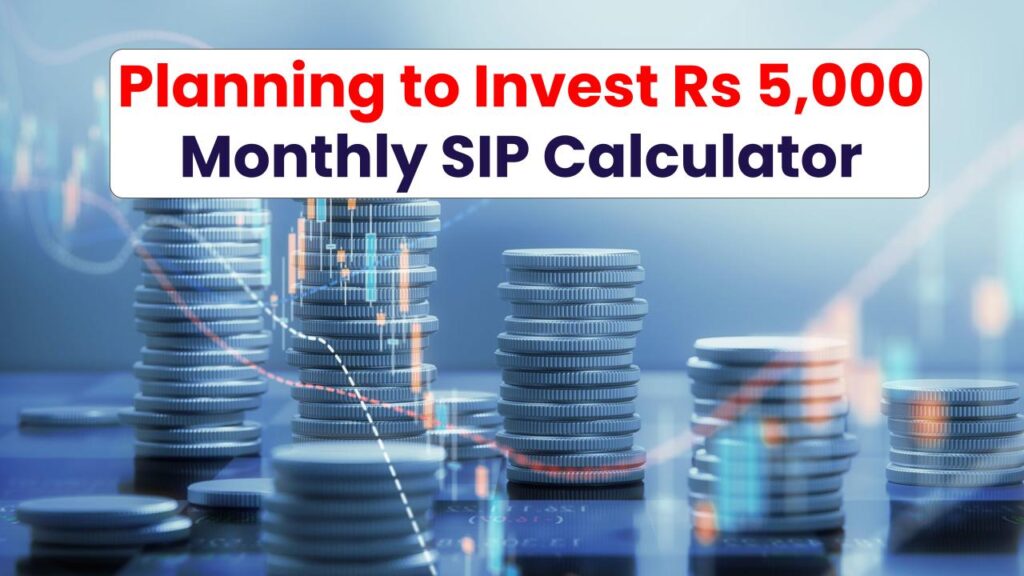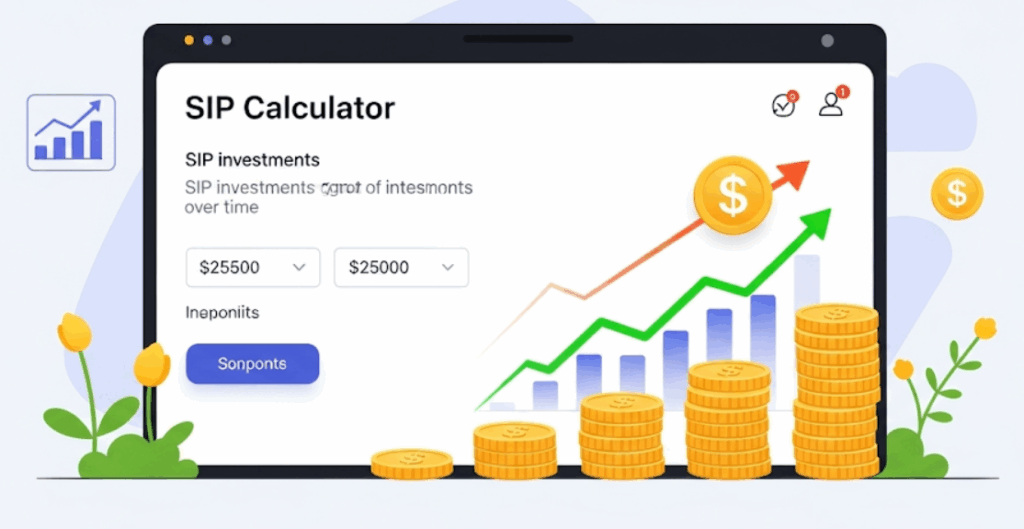If you’re thinking about investing Rs 5,000 every month through a Systematic Investment Plan (SIP), you’re on the right track! SIPs have become one of the most popular ways to grow wealth in India, especially for first-time investors. They offer a disciplined and relatively low-risk approach to investing in mutual funds. But how much can you earn by investing Rs 5,000 monthly? Well, that’s where a SIP calculator comes into play.

In this article, we will dive into the benefits of SIP, explain how it works, and show you what you can expect to earn in the next 5, 10, and 15 years if you invest Rs 5,000 monthly.
Planning to Invest Rs 5,000 Monthly
| Key Topic | Key Insights |
|---|---|
| SIP Investment Amount | Investing ₹5,000/month |
| Estimated Returns | Depending on returns (8% to 15%), expect ₹4.12 lakhs in 5 years, ₹11.61 lakhs in 10 years, and ₹25.22 lakhs in 15 years. |
| Average Return Rate | 12% annual return is used for example purposes, but actual returns can vary based on market conditions. |
| Total Investment | ₹60,000/year or ₹3,00,000 in 5 years, ₹6,00,000 in 10 years, ₹9,00,000 in 15 years |
| SIP Calculator Tools | Use online tools like Groww, ClearTax, or ICICI Bank SIP calculators to estimate your returns. |
| Investment Strategy | SIPs work best with a long-term view, consistent investments, and smart fund choices. |
Investing Rs 5,000 every month through a Systematic Investment Plan (SIP) can be a powerful way to build wealth over time. By staying consistent with your investments and choosing the right funds, you can expect significant growth in your corpus, whether it’s in 5, 10, or 15 years. SIPs are a simple, disciplined way to invest, especially for beginners, and with the right strategy, they can help you achieve your financial goals.
Introduction to SIP: What Is It, and Why Should You Care?
Before we dive into the numbers, let’s first understand what an SIP (Systematic Investment Plan) is and why it has become the go-to method for investing in mutual funds. In simple terms, an SIP is a way to invest a fixed amount of money regularly in a mutual fund scheme. It could be ₹500, ₹1,000, ₹5,000, or even more. The idea is to invest small amounts over time, which can add up to substantial wealth through the power of compounding.
The beauty of SIPs is that they don’t require you to be an expert investor. You don’t need to time the market or know when to buy and sell stocks. By investing regularly, you buy more units of the fund when the price is low and fewer when it’s high. This strategy helps to smooth out the ups and downs of the market, making it a less risky option for beginners.
How SIP Works
Let’s break down how an SIP functions. You commit to investing a fixed amount every month, and your money is automatically deducted from your bank account and invested in a mutual fund of your choice. Over time, the fund’s value can grow as the stock market (or the assets the fund invests in) performs well.
Here’s the beauty: you don’t need to be an expert in the stock market. Whether the market is up or down, your SIP invests the same amount regularly. This is called dollar-cost averaging, and it’s one of the key reasons SIPs are so effective for long-term wealth-building. It removes the emotion and guesswork from investing, which is especially valuable for beginners or anyone who’s new to the investment game.
Understanding the Returns: What to Expect from Your ₹5,000 SIP Investment
Now, the big question: how much will you earn by investing ₹5,000 every month through an SIP? To give you a better idea, we’ll explore what the corpus could look like in 5, 10, and 15 years, assuming different average return rates.
Example 1: SIP Returns at 12% Annual Growth (Common Market Return)
- 5-Year Investment
- Total invested: ₹5,000/month x 60 months = ₹3,00,000
- Estimated return: ₹1,12,432
- Total corpus: ₹4,12,432
- 10-Year Investment
- Total invested: ₹5,000/month x 120 months = ₹6,00,000
- Estimated return: ₹5,61,000
- Total corpus: ₹11,61,000
- 15-Year Investment
- Total invested: ₹5,000/month x 180 months = ₹9,00,000
- Estimated return: ₹16,22,000
- Total corpus: ₹25,22,000
Note: These estimates assume an average return of 12%. Your actual returns may vary depending on the mutual fund’s performance, market conditions, and other factors.

Factors That Affect SIP Returns
While SIPs are designed to be a long-term investment tool, it’s important to remember that market conditions can influence returns. Here are a few key factors to keep in mind:
1. Market Volatility
- The stock market can go up and down in the short term. However, over the long run, the market tends to grow. Investing through SIPs helps you ride out short-term volatility.
2. Fund Type
- Your returns depend on the type of mutual fund you invest in. Equity funds, for instance, typically offer higher returns but come with higher risk, while debt funds offer lower returns but are more stable.
3. Time Horizon
- The longer you stay invested, the greater the chances of compounding working its magic. For short-term goals, SIP might not deliver as much, but for long-term goals (5 years or more), it can really grow your money.
4. Interest Rates
- The performance of your SIP is also impacted by the interest rates in the economy. If the economy is doing well and interest rates are low, stock markets tend to perform better, and thus, your SIP could earn more.
How to Choose the Right SIP Fund
Selecting the right SIP mutual fund is crucial for maximizing your returns. Here are some steps to help you choose:
- Assess Your Risk Tolerance
- Determine whether you want a high-risk, high-return fund or a safer, lower-return option. For example, equity funds are more volatile but can offer greater returns, while debt funds are less risky but also offer lower returns.
- Understand the Fund’s Past Performance
- Past performance is not a guarantee of future results, but it can give you an idea of how the fund has performed over time. You can check a fund’s historical performance on platforms like Groww or Moneycontrol.
- Diversification
- If you want to minimize risk, consider investing in a diversified fund. This means the fund invests in a wide range of assets, reducing the impact of any one asset’s poor performance.
FAQs
1. How much money will I have after 10 years if I invest Rs 5,000 every month?
- If you invest ₹5,000 every month for 10 years with an annual return of 12%, you can expect a total corpus of approximately ₹11.61 lakhs.
2. Can I stop my SIP investment after a few years?
- Yes, you can stop or change your SIP at any time. However, for the best results, it’s advisable to stay invested for the long term to benefit from compounding.
3. How can I track my SIP investments?
- Most mutual fund platforms, such as Groww and ETMoney, allow you to track your SIP investments online. You can also check your mutual fund statement regularly.








